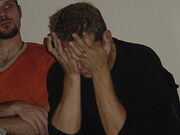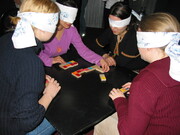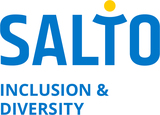Working with Blind people or Partially-Sighted
- This and more in the SALTO Inclusion for All booklet: No Barriers, No Borders
There are a variety of visual impairments, ranging from colour blindness, absence of seeing depth, not seeing in the dark, bad eyesight to total blindness. Find out from your participants what exactly their impairment is and how you could adapt your activities so that they can participate.
Some tips & tricks to keep in mind
- Provide orientation points in the working and living spaces - do a tour of the space ( by touch) you will be working/sleeping in
- Read out/mention all the things you show or do, e.g. when you write something on a flipchart, when you stick signs on the wall, etc
- It is possible to prepare 'three dimensional flipcharts' with things in different texture stuck on it, e.g. different texture tape, thick paint, etc so that blind persons can come and feel it - this should not replace, but add to the spoken information.
- In the beginning when meeting blind people or people with a visual impairment, identify yourself when speaking, till they start recognising the voices. In group discussions, make clear who you are speaking to.
- Give verbal indications of how discussions or activities are proceeding, e.g. say aloud who has raised their hand to speak, summarise what you see on people's face (agreement, incomprehension).
- Give information about what is happening, give points for orientation (e.g. if people are changing position, if people are sitting on the floor, if people have closed their eyes,...). Tell blind people when you are leaving!
- Don't use 'here' and 'there' but describe these places according to the orientation points the blind persons know or go to these places and say 'here'.
- Ask aloud if people want to add or ask things (because often we do this with a questioning face expression only)
- Provide, as afar as possible, all written materials before the activity either in large print format so that they can read it (with a magnifying glass if needed) or in electronic format to read it with a braille reader. Alternatively, you can ask a local organisation for people who are blind or partially-sighted to print your texts in braille.
- Use touch/hands more in your activities - allow for presentations that can be heard or felt, e.g. theatre, living statues, clay or other constructions,...
- Use colours to reinforce directional guidance for people who are partially-sighted (to the different rooms, to the exit, to working groups)
- Exercises with blindfolds can be useful to integrate the Blind (mostly they are more efficient at these activities than seeing participants). However some blind participants can be sensitive to these activities, as they will not be able to take of the blindfold at the end of the game. Also one could reflect on the fact that the sudden change in seeing or not would be just as confusing for the seeing person with a blindfold, as it would be for a blind person who would all of a sudden see again for an hour.
- If there is a visual interpreter who explains what is happening, who reads what is written etc, allow time for this translation (talking) and for possible late(r) questions or comments. Check regularly if they need more time.
- Blind people focus on sounds, so avoid exercises activities in places where there is lots of background noise (streets, machines,...) or loud music in the background. Make sure people speak loudly and clearly enough.
- The most common colour blindness is the inability to distinguish red and green. Do not use these two colours to put contrast in a drawing or text.
- If you use a flipchart or blackboard: write big and thick enough, so that people with a visual impairment (and others) can see it clearly. Use contrasting colours (black on white or white on black. Red and green are most difficult to see from a distance).
- Avoid putting obstacles in the way. One type of obstacle is the type that stick out above ground level (they cannot be felt by using a cane) e.g. bunk beds, tables with central legs instead of legs on the corners, things sticking out from the wall, passage ways under stairs,... Other obstacles are the ones below waist-height (they cannot be felt when feeling the way with their hands) e.g. boxes on the floor, low fences or steps,...
- Do inform blind participants or people with visual impairments of a change in the setup of the room, e.g. if you rearranged chairs for a session, if you created a little stage for a theatre play etc.
- Do not grab or push a visually impaired person in the direction you think they want to go - ask first if they need assistance and how they wish to be guided.. Most blind people will take your arm or elbow. This way they can walk half a step behind you and gain information about steps etc. Give information about how and where you are moving (e.g. number of steps, going outside, passing orientation point X, etc)
- If a blind participant is assisted by a guide dog, make sure the other participants don't distract and start playing with it - unless they have asked the owner. Also provide pee and drink breaks for the dog.
- If you help blind people with their meals, you can use the clock to indicate where the different food is located on the plate, e.g. 3 o'clock is to the right and 9 o'clock is to the left.
- Always make sure that there is one person 'in charge' of a blind person or a person with a visual impairment, to avoid this person getting lost or bumping into someone or something, especially outside of the known environment, e.g. in a new town, outside, while travelling,...
- Be clear about roles - who is the interpreter - who helps when and for what (not). The team cannot be expected to help all the time, but they can ask some of the participants to assist (e.g. with an exercise)
- ...
^^ top ^^
Accessibility guidelines for the Blind and people who are partially-sighted
- Are guide-dogs allowed (in the hotel, transport, restaurants, meeting places)? Can they arrange food for the dogs? Are there any extra costs?
- Are there any hazardous protruding objects (above waist level) which the blind person could bump into? Therefore bunk-beds, passage-ways under stairs, etc are not advisable.
- Is there braille signalisation or raised signs and symbols in places where the blind participant would go ( on their own)? These signs and symbols should be positioned where they can be touched. Knobs on the floor at curbs, steps, etc.
- Do lifts have voice announcements on which floor it stops, when doors are closing, etc? Do push buttons have braille on them?
- Avoid fast-closing automatic doors and plate glass doors with no colour-contrast. Avoid signalisation in red-green (for the colour-blind)
- Wherever possible locate important functions centrally - try to group rooms used by persons with a disability closer together.
- Are there handrails along stairs and corners? Avoid winding and angled routes - stick to straight angled layouts.
- Light switches and doorknobs should be approx. 104cm high
- What are the procedures in place in case of an emergency? How will blind participants be evacuated?
^^ top ^^

 Inclusion - not as easy...
Inclusion - not as easy...
Downloads
The following downloads are available:
- No Barriers No Borders - international mixed-ability projects - 2008 update
How to set up international projects with young people with and without a disability. With lots of tips & tricks about partnerships, funding, working with disability,... Based on SALTO TC Enable 2003
